
Eremothera boothii is a species of wildflower known as Booth's evening primrose. This plant is native to the western United States and northwestern Mexico where it is most abundant in arid areas such as deserts. This is an annual plant with hairy reddish-green stems and mottled foliage. The stem ends in a nodding inflorescence of many small flowers which may be white to red or yellowish, often with darker shades on the external surfaces of the four spoon-shaped petals. They have long stamens with clublike yellowish anthers. Flowers of this species tend to open at dusk rather than dawn as in many other Camissonia. The fruit is a twisted capsule one to 3 centimeters long. Plant appearances may vary across subspecies.

Castilleja rubicundula is a species of Indian paintbrush known by the common name cream sacs.

Clarkia gracilis is a species of wildflower known by the common name slender clarkia. This plant is native to the US states of California, Oregon, and Washington, where it is found in coastal, foothill, valley, and low-elevation mountain habitats. The plant is variable across subspecies but is generally an erect slender stem with a few sparse, narrow leaves several centimeters long. It bears an inflorescence of drooping buds which open into bowl-shaped flowers with pinkish lavender petals 1 to 4 centimeters long and bearing a red or white splotch which can appear in the center or at the base of the petal, depending on the subspecies.
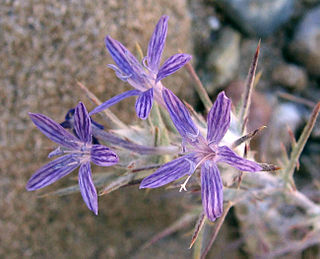
Eriastrum densifolium is a species of flowering plant in the phlox family known by the common name giant woollystar. This wildflower is native to California and Baja California where it grows in open areas such as sand dunes and dry washes. It grows on an erect stem with slightly hairy to densely woolly foliage, often giving the plant a dark gray-green color. The leaves are narrow and spike-shaped with pointed lobes. The top of each stem is occupied by a bunched inflorescence full of woolly leaflike bracts and funnel-shaped, flat-faced flowers. The flowers are each 1 to 3 centimeters long with a face up to three or four centimeters wide. The lobes are white to bright, striking blue, sometimes with longitudinal pinstripes. The stamens protrude from the throat.
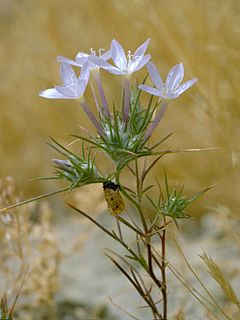
Eriastrum pluriflorum is a species of flowering plant in the phlox family known by the common names Tehachapi woollystar and many-flowered eriastrum.

Ipomopsis tenuifolia is a species of flowering plant in the phlox family known by the common name slenderleaf skyrocket, or slenderleaf ipomopsis. It is native to Baja California with its range extending just into California and Arizona, where it is a plant of the deserts and chaparral. This is a perennial herb taking the form of a neat clump of slender, erect multibranched stems reaching a maximum height near 40 centimeters. The leaves are narrow to threadlike and occur all along the stem branches. The inflorescences appear at or near the tips of the branches and each holds one to seven bright scarlet flowers. Each flower is a tube 1 to 2 centimeters long opening into a flat or bell-shaped corolla with squared or toothed lobes. The five stamens and one style protrude far out of the mouth of the flower. The stamens have white to purple anthers and the style has three whitish stigmas.
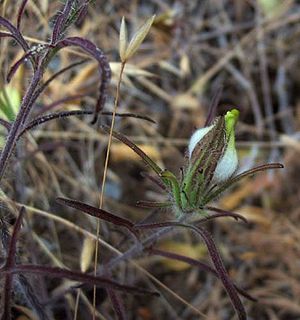
Cordylanthus rigidus is a species of flowering plant in the family Orobanchaceae known by the common name stiffbranch bird's beak.
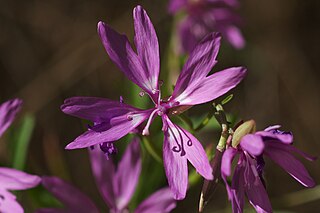
Clarkia biloba is a species of flowering plant in the evening primrose family known by the common name twolobe clarkia and two lobed clarkia.

Clarkia speciosa is a species of flowering plant in the evening primrose family known by the common name redspot clarkia. It is endemic to California, where it is known from the Central Coast and mountains and from the Sierra Nevada foothills. The plant is variable across its intergrading subspecies, taking a decumbent to erect form with a stem up to about half a meter long. The open or dense inflorescence has opening flowers and several closed buds. As the bud opens the sepals all separate from each other. The fan-shaped petals are up to 2.5 centimeters long and may be lavender to pink to deep red, sometimes fading to white or yellowish at the base. There is sometimes, but not always, a large bright red spot near the middle of the petal.
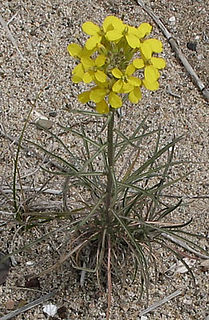
Erysimum insulare is a species of Erysimum known by the common name island wallflower. It is endemic to coast of southern California, including the Channel Islands. Erysimum insulare grows on coastal bluffs and sand dunes.

Monardella hypoleuca is a species of flowering plant in the mint family, known by the common names thickleaf monardella and white leaf monardella.
Pentachaeta exilis is a species of flowering plant in the aster family known by the common name meager pygmydaisy. It is endemic to California, where it is known from the North Coast Ranges to the southern Central Valley, San Joaquin Valley, and Sierra Nevada foothills. It is a member of grassland and woodland plant communities.
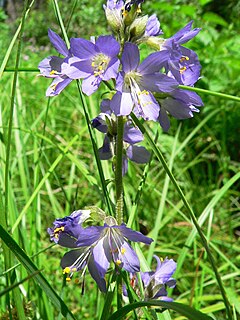
Polemonium occidentale is a species of flowering plant in the phlox family known by the common names western polemonium and western Jacob's-ladder. There are two subspecies. The common ssp. occidentale is native to western North America from British Columbia to Colorado to California, where it can be found in moist areas of many habitat types, including meadows and woodlands. There is also a rare subspecies, ssp. lacustre, which is known only from a total of three counties in Minnesota and Wisconsin, and is found only in white cedar swamp habitat there.

Silene campanulata is a species of flowering plant in the family Caryophyllaceae known by the common names Red Mountain catchfly and bell catchfly. It may be a synonym of Silene greenei.

Stellaria borealis is a species of flowering plant in the family Caryophyllaceae known by the common name boreal starwort. It has a circumboreal distribution, occurring throughout northern areas of the Northern Hemisphere. It occurs in many types of moist and wet habitat, including marshes, riverbanks, lakesides, floodplains, talus, ditches, and moist spots in forests and woodlands. It is quite variable in appearance, especially across subspecies. In general, it is a rhizomatous perennial herb forming mats of branching, four-angled stems lined with lance-shaped leaves a few centimeters in length. The inflorescence bears many flowers each with five deeply lobed white petals. Some flowers lack petals and have only the five pointed green sepals.

Streptanthus albidus is a species of flowering plant in the mustard family known by the common name Metcalf Canyon jewelflower. It is endemic to California, where it is known only from the Central Coast Ranges and San Francisco Bay Area. It grows in open areas such as grasslands, often on serpentine soils.
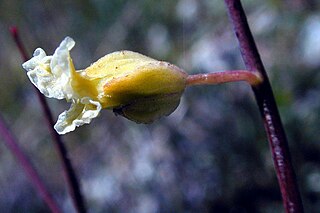
Streptanthus glandulosus is a species of flowering plant in the mustard family known by the common name bristly jewelflower. It is native to California and southwestern Oregon, where it grows in many types of habitat, including grassland, chaparral, and woodlands. Genetic and other analyses indicate that it is a species complex with ten subspecies which evolved as populations were isolated from each other. The complex includes subspecies previously considered separate species, such as the rare Tiburon jewelflower endemic to the San Francisco Bay Area. Plants in the complex are variable. In general they are annual herbs growing 10 centimeters to over a meter in height. They may be hairless to hairy to bristly. The ephemeral basal leaves have blades borne on winged petioles. Leaves higher on the stem are linear to lance-shaped and clasp the stem at their bases. Flowers occur at intervals along the upper stem. Each flower has an urn-shaped calyx of sepals one half to over one centimeter long which can be most any color from white to yellowish to pink or purple to nearly black. Purple, white, or purple-veined white petals emerge from the tip. The fruit is a straight or curving silique up to 11 centimeters long.
Streptanthus insignis is an uncommon species of flowering plant in the mustard family known by the common names plumed jewelflower and San Benito jewelflower. It is endemic to California, where it is known only from the Inner Central Coast Ranges. It grows in grassland and chaparral habitat, usually on serpentine soils. It is an annual herb producing a hairy, bristly, branching stem up to about 60 centimeters long. The lance-shaped basal leaves are borne on short petioles. Leaves midway up the stem are longer, and those near the top are shorter. They sometimes clasp the stem at their bases. Flowers occur at intervals along the upper stem. The uppermost flowers are often sterile and different in form. Each fertile flower has a bell-shaped calyx of sepals which is purple or greenish-yellow depending on subspecies. The petals at the tip are purplish or yellowish, also depending on subspecies. The fruit is a flat, straight silique which may be over 11 centimeters long.

Triphysaria eriantha is a species of flowering plant in the family Orobanchaceae, known by the common names johnny-tuck and butter-and-eggs.

Veronica peregrina is a species of flowering plant in the plantain family known by several common names including neckweed, American speedwell, purslane speedwell and hairy purslane speedwell. It is native to the Americas, and is known on other continents as an introduced species and a common weed. It can be weedy in its native range as well, growing on roadsides, on fields, and in other disturbed habitat. It is an annual herb growing from a taproot. The two subspecies are defined generally on the basis of hairiness: ssp. xalapensis is coated in glandular hairs and ssp. peregrina is a hairless variety. The plant produces erect stems up to about 30 centimeters tall. The leaves vary in shape from linear to lance-shaped to spoon-shaped with smooth or serrated edges; the lower leaves are borne on petioles. The inflorescence is a loose terminal raceme of flowers and lance-shaped bracts. The flowers are generally white and 2 or 3 millimeters wide.


















